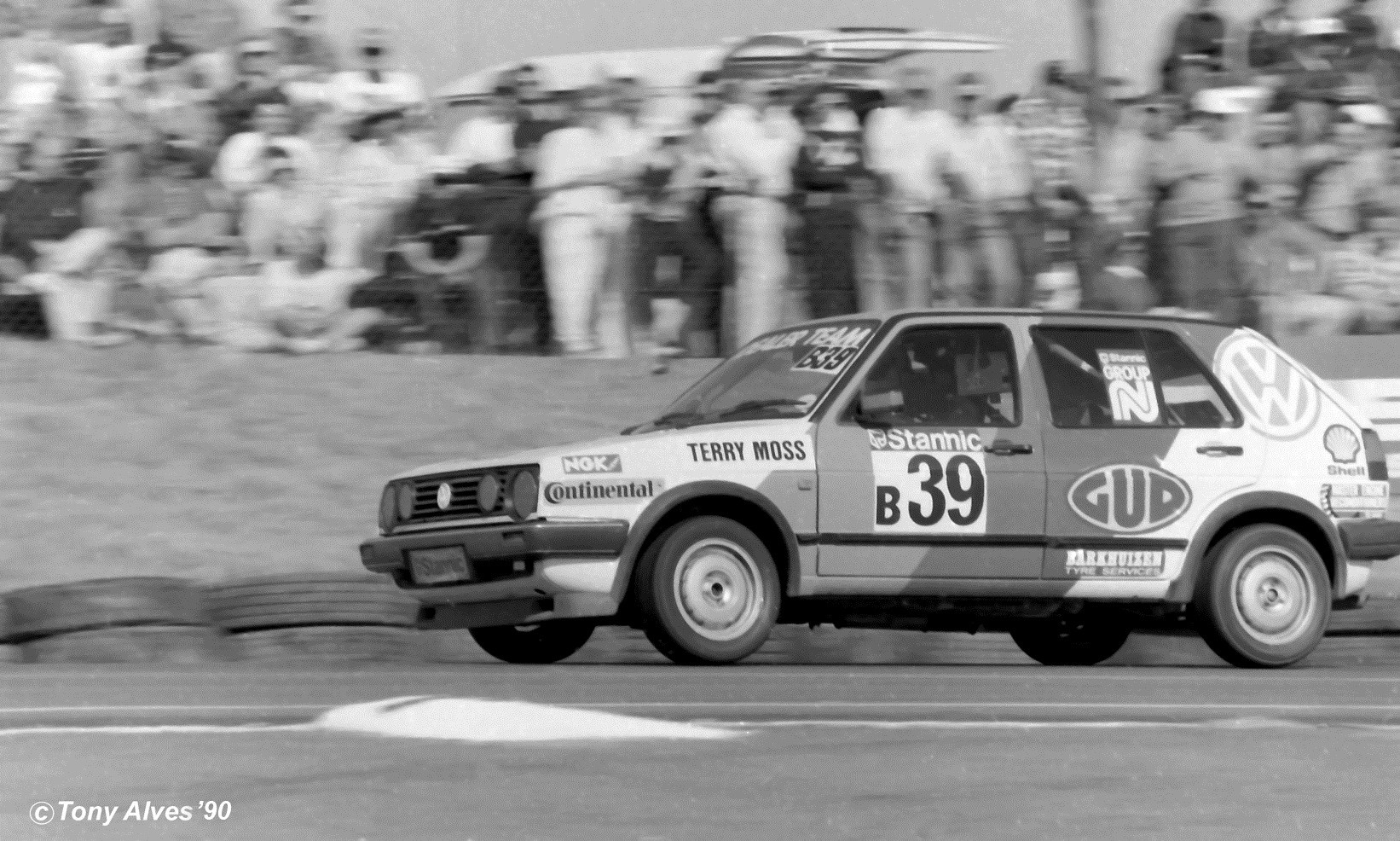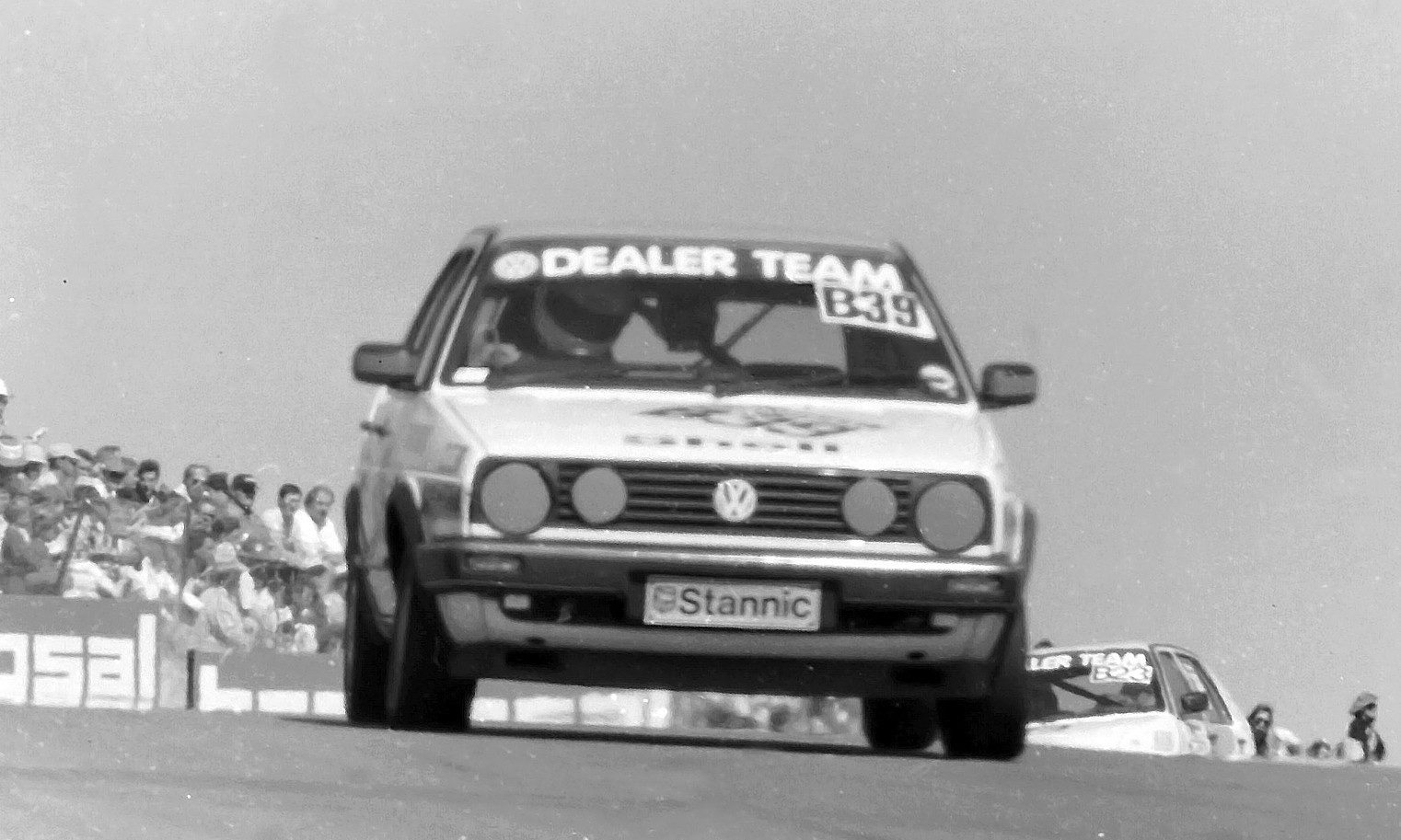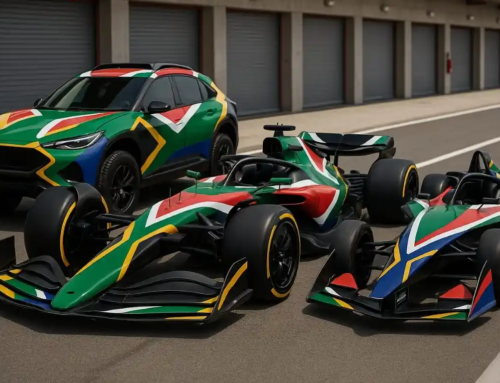Ever heard of the secret VW Golf Spitze? No? Well, Double Apex brings you an exclusive interview with someone who was intimately involved with the stillborn, SA-specific homologation-special Golf Mk2 that was bred for the track.
Special thanks to Sagren Nair for his input, without whom this piece would not have been possible, and to Tony Alves Media for the images.
South African motorsport enjoyed massive motor manufacturer involvement in the late 1980s and early ’90s. War was being waged between works outfits from BMW, Nissan, Opel, Volkswagen, et al on local racetracks in the popular Group N (for standard road cars) formula. Fields were consistently above 40 cars per meeting. Thousands of trackside fans were brought to their feet as racing heroes driving their favoured brands battled nose-to-tail and door-to-door at all SA’s major circuits. And for those far away from the track events were broadcast live on terrestrial television.
Follow Double Apex on Instagram and Facebook where we share more car content.
Manufacturers were keen to cash in on the credo: Win on Saturday, Sell on Monday. Some OEMs even went as far as producing homologation specials to beat the competition. Most notable of these are the, now iconic, BMW 325iS and the Opel GSi 16v S. Another limited-edition special was supposed to join the ranks but it didn’t see the light of day. We chat with ex-VW Motorsport engineer and racer during the era, Sagren Nair about the VW Golf Spitze.
Click here to learn why we no longer see exciting small-scale road-going homologation specials.
Double Apex: What was the idea behind the VW Golf Spitze project?
Sagren Nair: This was a natural progression for us at VW. We were inspired, in part, by the iconic “Superboss” and (325)iS. Also, our loyal drivers in Group N were clamouring for something new and wanted to be competitive again. We knew we had a superior chassis as the Mk2 VW Golf, with a sub-frame-mounted steering and control arms, was a lot more composed and rigid as standard, coupled with good brakes (from the Corrado) it was a good starting point.
Dbl Apx: What were the key changes to the Spitze over a regular 2,0-litre GTI 16V?
SN: The initial plan was to have gas-flowed heads with high-lift camshafts along with optimised fuelling and ignition curves. Tubular manifolds and freer-flowing exhausts (within legal limits) along with wider 15-inch rims and further stiffened up suspension were also part of the package.
Dbl Apx: Were the parts sourced from other VW Group cars or performance parts suppliers?
SN: The cylinder heads came complete with valves, gas-flowing and cams from Schrick Motorsport. Schrick was based in Lichtenstein and was headed up by Herr Lehmann a very pleasant guy and genius tuner who I had the honour to meet and discuss engine testing. For a second opinion we also consulted with local tuners such as Peter Lanz, Roger Taylor and Peter de Weerdt. But even these legends could not do much to help as the package was not ideal.
Learn more about the world’s first VW Golf racecar at this link.
Dbl Apx: How much power did the VW Golf Spitze make?
SN: Sadly due to numerous design limitations we reached the development ceiling very early in the process; these I will list below. But to answer your question we made 128 to 130 kW.
Our engine issues:
VW engine facilities worldwide had all machines set to 88 mm bore-centre spacing. The EA827 engine family right from 1100 cm3 to the V8s were set on this. This sadly allowed a maximum bore of 82,5 mm necessitating a stroke of 92,8 mm for a 2,0-litre displacement. This stroke length made for excessively high piston velocities. Opel’s 2,0-litre has a square 86 x 86 mm (bore x stroke) the shorter stroke is ideal for high revving and the bore size created an optimal combustion chamber area.
Secondly, our engine had a semi Pentroof combustion chamber with the exhaust valves sitting flat on the head, so one could not bump up the compression ratio. Opel had hemispherical combustion chamber, short tracts and allowed bigger valves. The Opel had a pedigree racing motor made sane for the street whereas we had a street motor that we were trying to modify to race.
Learn about the world’s quickest Golf by clicking here.
Dbl Apx: Do you recall if VW Motorsport had chosen the drivers who would compete with this car?
SN: Drivers were not chosen at that stage, but the motors were prepared at the engineering dynos by me and team, fitted in the cars and I used to set-up and take the cars to Aldo Scribante for Terry Moss to establish lap times. Drivers on the shortlist were Marthinus Briers, John Round, etc. I would have campaigned the “engineering car” as I normally did back then.
Dbl Apx: Did you do any racetrack testing, if so, how did it stack up against the front-running cars of the time?
SN: Yes all testing was done at Scribante with Terry mostly and the times were pretty close to the competition, thanks to the “Terry Moss factor”. I drove the car bit too and compared to my Class B 1,8 16V it was great; I loved it. The decision on whether to produce the cars was ultimately not decided on lap times but rather a management verdict based on a Benchmarking Road test held up in the old Eastern Transvaal and at Gerotek Test Facility.
Brian Gush was then head of Engineering Design (Gush went on to become head of Bentley Motorsport for 20 years and took the works team to overall victory at Le Mans – Ed) and De wet Hickman was Test & Development head. Together with Andre van der Watt of VW Motorsport and several of the other directors decided that the car was marginally better in street form and not a guaranteed race winner. VW Motorsport at this stage was racing the big Audi Quattros in Wesbank Modifieds and Touring Cars were on the horizon. Also, Golf 2 was to be soon succeeded by Golf 3 with the VR6; but that’s another long story. All these factors meant costly development on Spitze was not a priority.
Read up about the VW Golf 8 GTI in this post.
Dbl Apx: What was the proposed production run of the VW Golf Spitze, and how many were actually produced?
SN: All cars were hand-built in our engineering department purely for testing and benchmarking exercises. A few were built for our managers and my supervisor De wet Hickman also used one as his daily driver.
Dbl Apx: Do you have any memorable stories of the development process?
SN: Yes it was a great time in my career when there was no Global Engineering. Local content played a major role and we had localised a significant amount of engine components ie blocks, heads, pistons, manifolds and fuel injection systems, etc. We could be innovative and do some real engineering then. With no emission controls we had free reign from Wolfsburg.
But Spitze was just part of the many projects we were running at that stage I was also principal test engineer on the five-cylinder bus engines and I was doing a lot of work on cylinder knock detection and control, I was fortunate to work for Mike Bond who was my mentor in engine testing. Mike eventually ran engine development at VW Motorsport. A few years later I had to pack up my racing aspirations to take up a two-year stint in Wolfsburg to do durability testing on TDI engines using higher sulphur lower grade refined diesel fuels.
Dbl Apx: What happened to the development cars?
SN: They were all retro-fitted back to standard form and none were ever sold, sadly.
(We chatted with seven people in four countries on three continents and could not source a single picture of a VW Golf Spitze – Ed.)




![2025 FIA WEC 24 Hours of Le Mans: Race Report and Ramblings [w/video]](https://doubleapex.co.za/wp-content/uploads/2025/06/2025-FIA-WEC-24-Hours-of-Le-Mans-start-500x383.webp)
![McLaren Project Endurance Debuts Le Mans Challenger [video]](https://doubleapex.co.za/wp-content/uploads/2025/06/McLaren-Project-Endurance-Le-Mans-Hypercar_03_edited-500x383.webp)
![Michael Schumacher At Le Mans [video]](https://doubleapex.co.za/wp-content/uploads/2025/06/a0052-500x383.webp)

I remember the rumours and even saw pictures of the Spitze. There was a competition at the time just before its official launch and one of the price give aways was a Spitze. It looked about 20mm lower than the original Mk2 GTi and it had 15inch BBS rims. The excuse we got was that VW was concerned about their customers safety and decided not to launch the car. I later bought a Superboss and learned it was actually because of the Superboss superior overall performance that made the Vw boyz bail out of the project. Sad because Vw had a quality and handling advantage over the Opels those years. Rip Spitze.
I was working at VW when these were being developed. I think all of them blew their head gaskets or some or other serious failure.
There was a south african tv series called Timestream 2020 that features all the vw’s. There was a spitze. I wish I could find that series. I think it was 1990. I can’t remember the plot but it was awesome to see the vw’s.
I saw the Spitze in its final trim on a competition where you could win a Spitze or a CTi Golf back in 1990. The only difference was 15″ BBS RIMS and a Spitze badge from the original 16v Golf. So sad VW did not launch it all because of the Opel GSi 16V S looking beter on paper.